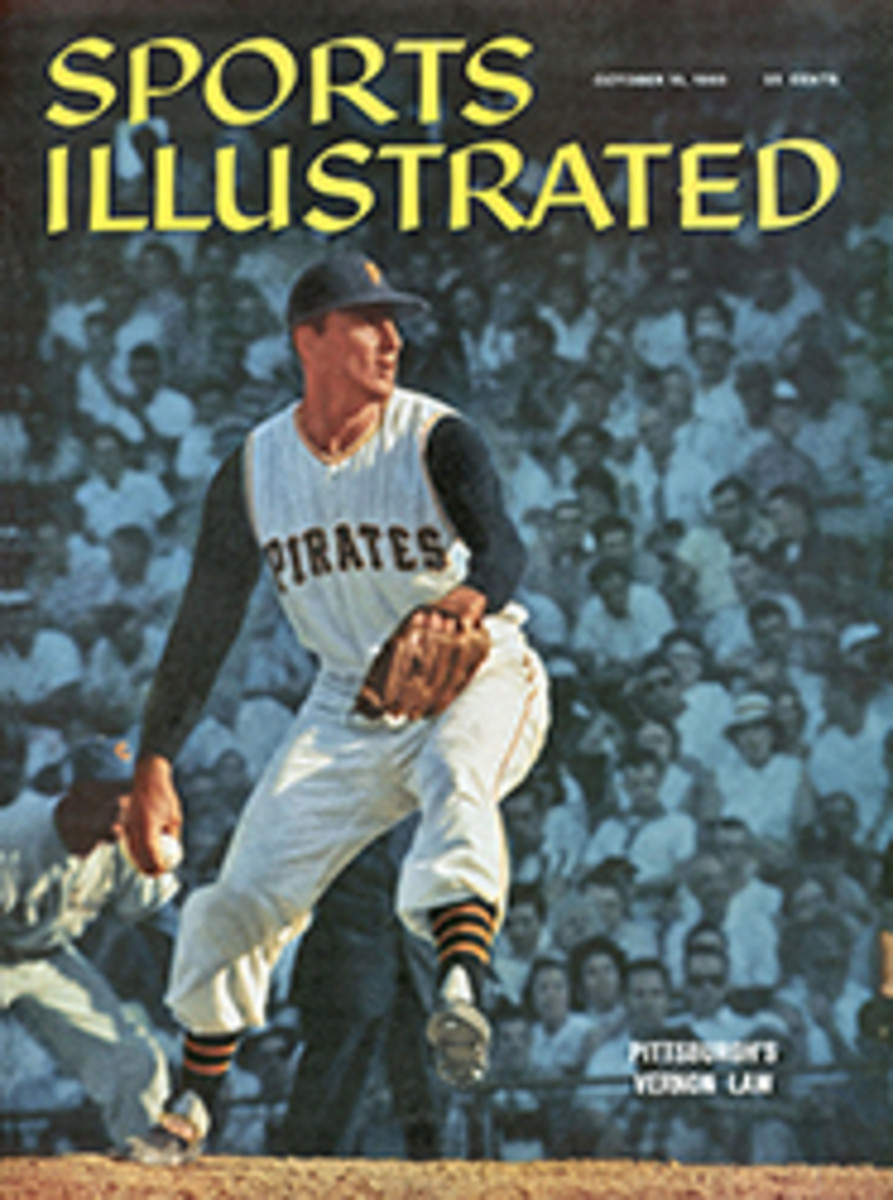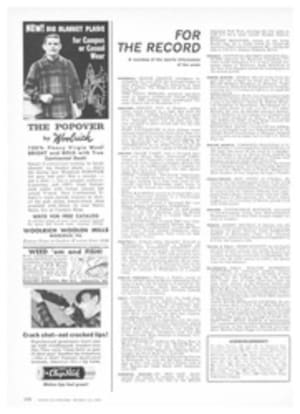
AN EPIC OF GOLF
HOW NICKLAUS STOLE THE SHOW AT PHILADELPHIA
At one o'clock last Saturday afternoon on the 18th green of the famous East Course of the Merion Golf Club near Philadelphia, young Jack Nicklaus braced himself over the final putt of his final round in the World Amateur Team Championship. He was about to climax the most exciting and memorable performance by an amateur golfer since Bobby Jones's Grand Slam in 1930. The day was sunny but chilly. A hushed gallery ringed the green and curled up the flanks of the 18th fairway. An American flag posted high behind the green snapped in the brisk wind. Nicklaus crouched lower and lower over his touchy five-foot putt.
Then suddenly, almost shockingly, a gust of wind snatched the green-billed white golf cap from Nicklaus' crew-cut head and plopped it on the green directly behind him. Without turning, without hesitating, Nicklaus stroked the ball into the cup.
The moment epitomized both the performance and the player. Seemingly unaffected by the rain, the wind or the problems presented by one of the world's most difficult golf courses, this 20-year-old Ohio State junior had shot sub-par rounds of 66, 67, 68 and 68 for a 72-hole total of 269. This score was 18 strokes below the total Ben Hogan posted while winning the U.S. Open at Merion in 1950. Nicklaus' 66 on the first day broke the amateur course record—a record that had stood for 36 years. His four-day score was 13 strokes better than the second man's in this field of the world's finest amateur golfers, and 19 strokes better than the third man. He led the U.S. team of four to a monumental 42-stroke victory over second-place Australia.
The fact that anyone could break Merion's rigorous par of 70 on four consecutive rounds was completely surprising. The fact that Nicklaus, at this particular time, should be the one to do it was even more unexpected. Since his second-place finish to Arnold Palmer in the U.S. Open last June, Nicklaus had been beaten in the NCAA tournament, had gotten married, had abandoned serious competitive golf for several weeks and had played erratically and been defeated in the U.S. Amateur just two weeks before coming to Philadelphia.
"When I went to St. Louis for the Amateur," Jack admitted last week, "I knew I would be beaten. I simply wasn't playing well enough to win it. I was inconsistent. One round I'd be three over par, the next seven under, the next three over again. I was still playing badly in my practice rounds here. In fact, after nine holes on my last practice round before the tournament I started to get worried. I went and told Tot [Totton Heffelfinger, nonplaying captain of the U.S. team] that I was hitting the ball so badly I was beginning to get scared. Then on the last nine holes I started hitting the ball well again. My game came back."
This surely is one of the understatements of the year. Swinging with the up-and-down power of a man hammering wooden stakes, Nicklaus drove the ball far and he drove it straight. Seldom in the rough, he was able to reach many of the 440-yard holes with a drive and an eight- or nine-iron, despite exceptionally soggy fairways that yielded no roll at all. Merion's East Course has 117 traps (the "White Faces of Merion"), and yet he trapped his ball only eight times in four days. Two of those came on his first two shots of the tournament.
The first day's play was muffled in fog and a fine, powdery rain that filtered into everything. Driving into the haze from the first tee, Nicklaus trapped his drive and then exploded his second shot out into another trap next to the green. But his third shot came out a foot from the hole and gave him his par. By the ninth hole he was two under par, and when he holed short birdie putts on the 10th and 11th the gallery realized that he had a good chance to break the amateur course record of 67 set in 1924.
Jack made sure of the record on the 17th hole, with his best shot of the day. The 17th is a 230-yard par-3 with an elevated tee and a green that flows down from the back and falls off sharply at the front like a waterfall. After peering through the misty rain Nicklaus chose a three-iron and smashed the ball in a white, blurry line toward the green. It rose slowly, then floated down seven feet from the hole—a birdie 2. Even three putts from 30 feet on the 18th for a bogey 5 could not keep him from the record after that one.
A shot to remember
Two days later Nicklaus hit a shot that golfers will be talking about for years. After going two under par with a birdie on the 15th, Nicklaus hooked his drive at the 16th into the rough on the left. This hole is 445 yards long and the green is fronted by a gully some 120 yards wide that is filled with sand and tall, brushy Scotch broom. A mass of trees along the side of the fairway blocked his approach to the green, so Nicklaus, using an eight-iron, hit the ball high and far out to the right. It sailed toward a group of trees and the spectators packed around the right side of the green. Then it hooked back to the left and bounced onto the green 20 feet from the hole. Nicklaus climbed up to the putting surface, tapped the ball and watched as it ran and ran and—just as it seemed about to stop short—toppled into the hole for a birdie 3. After that, his 68 on the final day—made with the tees pushed back as far as they would go and the pins put in the most difficult positions-seemed anticlimactic.
The exceptional display of golf by Nicklaus overshadowed a rather magnificent joint effort by the rest of the U.S. team. Deane Beman, current U.S. Amateur champion, who scored 67 on the second day and 69 on the third, finished second to Nicklaus on the individual list with a 282 total. Bob Gardner, runner-up to Beman in the Amateur, had a 68 on the third day and a 72-hole total of 289. Bill Hyndman III, the only one of the Americans who had played Merion before last week, shot 67 on the third day and tied Gardner at 289. No foreign player broke par on any round, and only 22-year-old Bruce Devlin, the Australian Open champion, could crash a U.S. sweep of the individual race. He finished third with a 288, just ahead of Gardner and Hyndman.
Also overshadowed by Nicklaus' four straight sub-par rounds was the significant international flavor of the event. This World Amateur Championship, in spite of the one-man show that emerged from Merion, is primarily a team event. This was the second biennial championship (the first was held at St. Andrews in Scotland two years ago), and 32 nations entered four-man teams. Each day each country's three best scores are added together, and after four days the team with the lowest overall total wins the championship and the Eisenhower Trophy. Merion was dotted with golfers from countries like Malaya (3,000 golfers, 30 courses) and Finland (400 golfers, six courses). There were turbaned, bearded Indians as well as a combined foursome from Great Britain and Ireland, where golf is so much a part of everyday life. Thirty-eight of the visitors never broke 80 in any round, four never got below 90 and one, Dr. J. Francis Silva, an orthopedic surgeon from Ceylon, failed to break 100.
"Back home at the Royal Colombo club I have an 8 handicap," Dr. Silva, who shot rounds of 102, 101, 102 and 117, said in his soft, careful English. "I can't say why I haven't done better. Maybe there's something wrong with our handicap committee."
PHOTO
JAMES DRAKE
PHOTO
JAMES DRAKE
IN WATERPROOF PANTS ON SECOND DAY NICKLAUS CHIPS AT 9TH
PHOTO
JAMES DRAKE
ON 16TH GREEN DURING THIRD ROUND NICKLAUS WATCHES INTENTLY AS 20-FOOT PUTT FALLS INTO HOLE FOR HISTORIC BIRDIE

